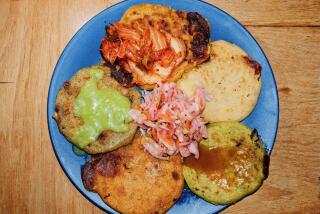Snap to the season
FORGET arugula. This has become the United States of andouille. And chorizo. And merguez. Sausages are the biggest temptations in the meat aisle lately, and when you mix and match them, you are on your way to a new menu for Memorial Day entertaining.
For a variety of reasons -- better ingredients, smarter marketing, the boom in artisanal foods -- sausages have never looked more appealing. You can buy turkey sausage and seafood sausage and infinite variations on chicken sausage, not to mention much improved Italian sausages, and they are so good there is no incentive to make your own. All these have the same seductiveness as bacon but come with added value: You can make a party of them, right off the grill.
And while sausages are perfectly fine partners for the usual potato salad, coleslaw and baked beans as the kickoff to summer, they match up even better with more imaginative side dishes and desserts. South American accents, in particular, are harmonious with the mixed flavors in a combination grill: papaya in a spinach salad, hearts of palm in a black bean salad, mangoes in an upside-down cake.
--
A wider reach
Sausages have been around as long as farmers have had extra parts from pigs, but these days they are not an afterthought. Sausage-making has become a competitive business, in farmers markets and supermarkets alike. Big companies such as Aidells and DâArtagnan are producing endless varieties, with the former specializing in flavors (Burmese curry, spinach and feta) and the latter more exotica (rabbit, venison, wild boar). Niman Ranch, among others, makes sausages using pork from heritage breeds. Even health food stores carry sausages now, and not only made from tofu.
What once would have been considered ethnic sausages are being marketed by the most mainstream producers. Merguez, made from ground lamb with hot spices, is becoming as common as beef hot dogs. Duck sausages, those erstwhile âfreedomâ sausages seen mostly in cassoulet, are now sold alongside Italian sausages.
Among other sausages, the difference is in the seasoning. Andouille has Cajun spices, for instance, while Mexican chorizo is hot with chile powder, and kielbasa contains allspice and marjoram.
Fresh sausages or smoked/cured sausages are best for grilling, and grilling is far superior to pan-frying, which leaves the links stewing in a puddle of fat. Both kinds need low heat and constant turning; fresh sausages will cook in 10 to 15 minutes while the smoked kind need only to be heated through. Sausages that qualify as salumi -- dry, firm, aggressively seasoned -- are meant for slicing thin, not serving whole.
The issue of nitrites and nitrates inevitably rears its unpleasant head with sausages, but not with the fresh kind, which thus have to be cooked within a day or so of being bought. Smoked and cured sausages use the curing salts to ward off botulism, although you can find varieties that do not. (A farmer once explained the difference to me when offering two choices in bacon: Holding up the nitrate-free package, he said: âHealthier.â And then he picked up the other and said: âTastier.â)
--
Bold, bright flavors
More AND more sausages are being flavored to within an inch of their links, with pesto and portobellos and other extraneous additives; about the only combination I think I have not seen is raspberry and chocolate. But the best choices are the most straightforward or traditional. A really great, snapping-fresh sausage tastes like the main ingredient, seasoned only enough to be jumping with flavor.
And those clean flavors complement a surprising array of others, especially any drawn from South American cooking. Even Middle Eastern merguez tastes surprisingly harmonious against tropical fruits.
Sausages as a main course can be served the way they are at Texas barbecue joints, as either knife-and-fork fare or with soft white bread or buns for sandwiching (mustard -- Dijon or Creole -- is optional). A couple of salads will round out the plate, and both can be made ahead. You can make dessert the night before as well -- when itâs cool enough for baking.
A spinach and papaya salad tastes both sweet and tangy against any fatty meat, but adding papaya seeds to the dressing produces an almost peppery accent. The seeds can be ground into the dressing in the blender, a trick I picked up at a tropical fruit garden near Miami back in the last century. Roasted, salted cashews bring the flavors together even more, with great texture. (You could substitute toasted sliced almonds for economyâs sake, or chopped macadamias if youâre feeling indulgent.)
Beans and sausage go together like potatoes and mayonnaise, black beans in particular. Mix the legumes with other elements of Brazilian cuisine -- hearts of palm, roasted red peppers, diced avocado and white onion -- and you get a sprightly blend in a cumin- and cilantro-spiked vinaigrette. This is one of those salads that get better as it sits overnight.
Dessert could be as simple as a bowlful of sliced mango tossed with a little rum and lime juice. Or you could take an extra step and fold those slices into a cold tapioca pudding. Even better are mangoes baked into an upside-down cake, to be served warm with whipped cream.
This simple menu can contract and expand. If more guests turn up, you can just lay more sausages on the grill. Or you can keep the party as small as six and serve them as a sit-down meal.
And while you could just serve Italian sausages or something equally familiar, mixing it up with ânewâ varieties makes for a more vibrant start to summer eating. This could be the year charcuterie gets a green card and becomes all-American festive food.
--
--
Spinach and papaya salad
Total time: About 20 minutes
Servings: 6 to 8
2 bunches young, tender spinach, stems removed
1 medium papaya
3 tablespoons red wine vinegar
1 tablespoon roughly chopped shallot
1 tablespoon sugar
1 teaspoon dry mustard
1 teaspoon Worcestershire sauce
1/4 cup peanut or canola oil
Salt to taste
1/2 cup coarsely chopped salted cashews
1. Wash the spinach well and dry thoroughly. Tear the leaves into bite-size pieces and place in a large salad bowl.
2. Cut the papaya in half and scrape out the seeds, reserving 1 1/2 tablespoons. Peel the papaya and cut it lengthwise into quarters, then crosswise into slices about one-fourth-inch thick. Add to the spinach and toss.
3. Combine the vinegar, shallot, sugar, mustard and Worcestershire sauce in a blender. Blend the mixture thoroughly. With the blender running on low speed, add the oil and blend until emulsified. Add the papaya seeds and blend until they are coarsely chopped. Season with one-fourth teaspoon salt, or to taste.
4. Toss the salad with half the dressing. Add more to your taste. Sprinkle with the cashews and serve.
Each serving: 138 calories; 2 grams protein; 9 grams carbohydrates; 1 gram fiber; 11 grams fat; 2 grams saturated fat; 0 cholesterol; 152 mg. sodium.
--
Brazilianesque black bean salad
Total time: 15 minutes, plus chilling time
Servings: 6 to 8
2 cups cooked, drained black beans (canned are fine, just rinse off the salt)
2 tablespoons minced white onion
3 tablespoons chopped fresh cilantro
3 tablespoons fresh lime juice
5 tablespoons best-quality olive oil
1 teaspoon ground cumin
Salt
Freshly ground black
pepper
1 red bell pepper, roasted, peeled, seeded and cut into about 1/2 -inch dice
1 cup diced hearts of palm
1 cup grape tomatoes,
quartered lengthwise
1 medium ripe Hass avocado, peeled, seeded and diced
1. In a mixing bowl, combine the beans, minced onion and cilantro. Add the lime juice, oil and cumin and mix well. Season with a scant one-half teaspoon salt and scant one-fourth teaspoon pepper, or to taste.
2. Stir in the red bell pepper, hearts of palm and grape tomatoes. Cover and chill 1 hour.
3. Just before serving, stir in the avocado. Taste and adjust the seasoning if necessary.
Each serving: 183 calories; 5 grams protein; 15 grams carbohydrates; 6 grams fiber; 12 grams fat; 2 grams saturated fat; 0 cholesterol; 82 mg. sodium.
--
Mango upside-down cake
Total time: About 1 hour
Servings: 8
2 medium mangoes, peeled and thinly sliced
2 tablespoons dark rum
4 tablespoons ( 1/2 stick) butter
1/2 cup packed dark brown sugar
1 1/2 cups cake flour
1 teaspoon baking powder
1/2 teaspoon kosher salt
Grated zest of 2 limes
1/2 cup (1 stick) butter, softened
3/4 cup sugar
2 large egg yolks, at room temperature
1/2 cup half-and-half
Whipped cream for garnish (optional)
1. Heat the oven to 350 degrees. Combine the mangoes and rum in a bowl and mix well. Let stand while you make the rest of the cake.
2. Melt 4 tablespoons butter in a heavy, 10-inch oven-proof skillet, set over low heat. Whisk in the brown sugar until smooth. Remove from the heat.
3. Arrange the mango slices evenly in the pan (as you would apples for a tarte Tatin). Pour the remaining juices evenly over.
4. Combine the flour, baking powder, salt and lime zest in a small bowl and whisk to blend.
5. Beat the one-half cup softened butter with the sugar until smooth. Beat in the egg yolks one at a time. With the mixer on low speed, beat in half the flour mixture, then half the half-and-half, then the remaining flour mixture and the remaining half-and-half. Beat until smooth. Spoon over the mangoes in the skillet, spreading the batter evenly to the edges.
6. Bake in the lower third of the oven for 35 to 40 minutes, until the cake tests done. Immediately invert the skillet over a serving plate. Serve the cake warm, with whipped cream, if desired.
Each serving: 443 calories; 4 grams protein; 62 grams carbohydrates; 1 gram fiber; 20 grams fat; 12 grams saturated fat; 102 mg. cholesterol; 148 mg. sodium.
--
Patio season
To see more photos, go to www.latimes.com/food.


